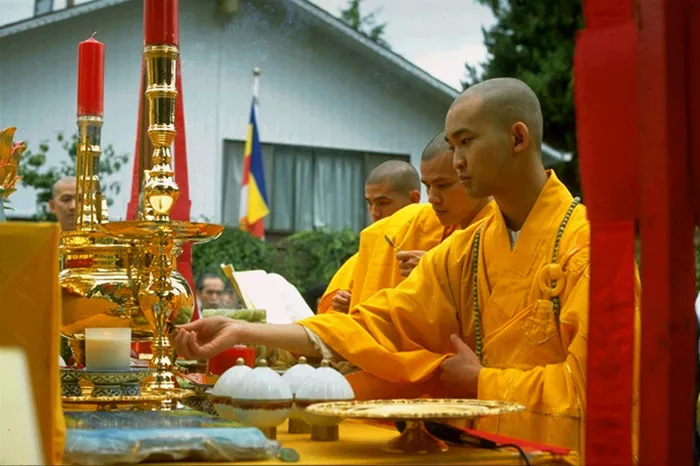Mahayana Buddhism is one of the two main branches of Buddhism. It started about 2,000 years ago and spread mainly in East Asia. Unlike some other religions, Buddhism focuses on the path to end suffering through understanding the mind and reality. Mahayana means “Great Vehicle,” which shows its aim to help many beings reach enlightenment.
What is Heaven in General?
In many religions, heaven is a place of eternal happiness and peace. People often think of heaven as a beautiful world where good souls go after death. It is a place free from pain, full of joy, and sometimes seen as the reward for good behavior during life.
Heaven in Early Buddhist Teachings
Before Mahayana, in early Buddhism or Theravada tradition, there is the idea of deva realms, often called heavens. These are special worlds where gods or divine beings live. They are very pleasant places with long life and great happiness. However, these heavens are not permanent. After their good karma finishes, beings are reborn in other realms based on their actions.
The Six Realms of Samsara
Buddhism teaches about samsara, the cycle of birth and death. There are six realms where beings can be reborn:
- Gods (Deva) Realm — often called heaven
- Demigods (Asura) Realm
- Human Realm
- Animal Realm
- Hungry Ghosts Realm
- Hell Realm
The god realm is blissful, but it is still part of samsara, the endless cycle of suffering and rebirth. So, even gods eventually leave their heaven and are reborn elsewhere.
Mahayana Buddhism and the Concept of Heaven
Mahayana Buddhism inherits the idea of heavens from early Buddhism but adds new ideas. It often focuses less on temporary heavens and more on the ultimate goal of enlightenment or nirvana. For Mahayana, the key is to escape samsara altogether, not just to be born in a pleasant realm.
Heaven as a Temporary Place
In Mahayana, heaven or the deva realms still exist. They are part of samsara, meaning they are temporary and not the final destination. Good people or beings with merit can be reborn there, but even heavenly life is limited and filled with subtle suffering.
Why Not Seek Only Heaven?
Mahayana teachings warn that seeking only heaven is not enough. Being born in heaven delays suffering, but it does not end the cycle of rebirth. The ultimate aim is to reach buddhahood, a state beyond all realms of existence, including heavens.
The Bodhisattva Ideal and Heaven
A unique feature of Mahayana Buddhism is the bodhisattva path. A bodhisattva is someone who chooses to delay full enlightenment to help others. Bodhisattvas work to save all beings from suffering, not just themselves.
Does a Bodhisattva Go to Heaven?
Bodhisattvas can choose to be born in heaven or any realm to help beings there. However, their main goal is not to enjoy heaven but to help others achieve liberation. They do not seek heaven as a final resting place.
Bodhisattvas and Pure Lands
Mahayana also teaches about Pure Lands, special realms created by enlightened beings like Amitabha Buddha. These are often described as paradises with perfect conditions to practice the Dharma. They are different from ordinary heavens because they are designed to help beings reach enlightenment quickly.
The Role of Pure Land Buddhism
Pure Land Buddhism is a major school within Mahayana. It focuses on devotion to Amitabha Buddha, who created the Western Pure Land. This Pure Land is often described as a blissful realm similar to heaven, but its purpose is to aid beings in reaching enlightenment.
Is the Pure Land Heaven?
Some may think the Pure Land is the same as heaven, but in Mahayana, it is more than that. It is a place free from the sufferings of samsara and a step closer to buddhahood. Being born there is seen as very fortunate because it supports spiritual practice without distractions.
The Ultimate Goal Beyond Heaven
Even though Mahayana acknowledges heavens and pure lands, the final goal is nirvana. Nirvana is the complete liberation from all suffering and the cycle of rebirth. It is beyond all concepts of heaven or any worldly or heavenly realm.
Nirvana vs. Heaven
Heaven is still part of samsara, so it is impermanent. Nirvana is permanent peace and freedom. Mahayana teaches that only reaching nirvana ends all suffering forever.
Why Mahayana Buddhism Teaches About Heaven
Mahayana Buddhism teaches about heaven and heavenly realms to help people understand the effects of karma and the different stages of existence. These teachings motivate ethical living and spiritual practice.
Heaven as Motivation
Heavenly rebirth is often described to encourage kindness, generosity, and moral behavior. It shows that good actions lead to better experiences. But Mahayana also teaches that aiming only for heaven is not enough.
Using Heaven as a Step
Heavenly realms can be helpful for spiritual progress. Being born in heaven allows beings to live longer and practice Dharma without much suffering. But practitioners should always keep the goal of full enlightenment in mind.
Conclusion
Mahayana Buddhism does believe in heavens, but it sees them as temporary places within the cycle of rebirth. These heavens are good but not the final goal. The ultimate aim is to become fully enlightened and free from all cycles of birth and death.
The bodhisattva ideal emphasizes helping all beings rather than just seeking heaven. Pure Land Buddhism offers a special kind of heaven that supports practice, but even this is a step toward enlightenment.
So, in Mahayana Buddhism, heaven exists but is not the ultimate answer. It is a place within samsara, and the real freedom comes from awakening beyond all realms.

